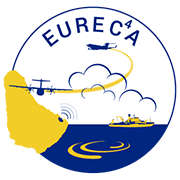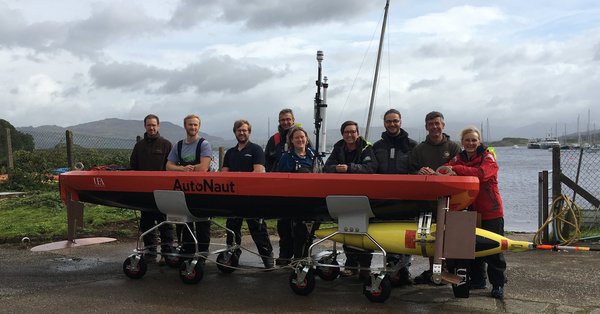Caravela, an Autonaut, and the Seagliders
An AutoNaut is a wave-propelled unmanned autonomous surface vessel designed to take meteorological and oceanographic measurements at the air-sea interface. The vehicle is fitted with solar panels to power the instrumentation, as well as a small propeller for thrust when there are no waves. UEA recently purchased a 5-metre AutoNaut, named Caravela. The focus of Caravela’s work during EUREC4A is to gather data to determine air-sea fluxes of heat and momentum. One advantage of using an AutoNaut for this work is that the disturbance to the ocean surface is much lower than using a ship, improving accuracy of measurements close to the ocean surface. In addition, Caravela is equipped to carry and release a Seaglider, such that vertical fluxes can be determined throughout the ocean boundary layer. These platforms provide the opportunity to collect data in remote and harsh environments at a fraction of the cost of ship-based fieldwork.
Seagliders are buoyancy-powered autonomous underwater vehicles that can profile to 1000 m depth every 4 h for up to 6 months. A Seaglider will repeatedly dive and climb to produce a profile of the upper ocean. During EUREC4A, we will deploy 3 Seagliders (1 from Caravela and 2 from the  R/V Meteor). These Seagliders will observe how the surface fluxes measured by the AutoNaut affect the near-surface ocean properties and processes.
R/V Meteor). These Seagliders will observe how the surface fluxes measured by the AutoNaut affect the near-surface ocean properties and processes.
Caravela's instrumentation
| Radiation | An Apogee CS301-Pyranometer measures short wave solar radiation in the range of 360 nm – 1120 nm. An Apogee SL510-Pyrgeometer is an upward-looking thermopile pyrgeometer used to determine incoming longwave radiation between 5 μm and 30 μm. |
| Meteorology1 | An Airmar 120WX provides apparent wind speed and direction, as well as air temperature. |
| Meteorology2 | Humidity and temperature are measured by a Rotronic HC2A –S3 standard meteo probe and a Rotronic MP402H-082000 sensor with a Rotronic AC1003 unit. Situated on the mast of the AutoNaut, these measurements are approximately 1m above the sea surface |
| Ocean state | A Valeport miniCTD is fixed through the bottom of the AutoNaut for continuous sampling of near-surface salinity and temperature. Additionally, we have a Nortek Signature1000 1 MHz Acoustic Doppler Current Profiler (ADCP) with a 5 beam set up for estimating velocity shear and biomass in the water column, range 30 m. |
Seagliders
The three seagliders will adopt different configurations of the available instrumentation as outlined below.
Configuration:
- SG579 Humpback: Seabird unpumped CT sail. Aanderaa 4130 oxygen optode. PAR sensor. Wetlabs triplet Ecopuck.
- SG637 Omura: Seabird unpumped CT sail. Nortek Signature1000 custom 4 head ADCP, 15 m range. Contros oxygen optode. WETLabs SeaOWL sensor.
- SG620 Seabird unpumped CT sail. Rockland Scientific MicroPod microstructure system: 1X shear 1X fast thermistor, both operating at 512 Hz.
Instrumentation
| CT Sails | An SG579 Humpbac Seabird unpumped CT sail measure temperature and salinity |
| Oxygen | Aanderaa 4130 oxygen optode measures dissolved oxygen concentration. |
| Ocean particulate | WETLabs SeaOWL measures crude oil-in-water, chlorophyll fluorescence and 700nm optical backscatter for particulate matter. Wetlabs triplet ecopuck measures chlorophyll fluorescence and optical backscatter at two wavelengths |
| Currents | Nortek Signature ADCP measures ocean current shear, from which absolute currents can be derived. |
| Turbulence | Rockland Scientific Micropod microstructure system measures ocean turbulence. |
PI/Contact:
Karen Heywood (K.Heywood@uea.ac.uk)
University of East Anglia

